Breaking Through: The Hubble Telescope
curiosity·@st3llar·
0.000 HBDBreaking Through: The Hubble Telescope
<center>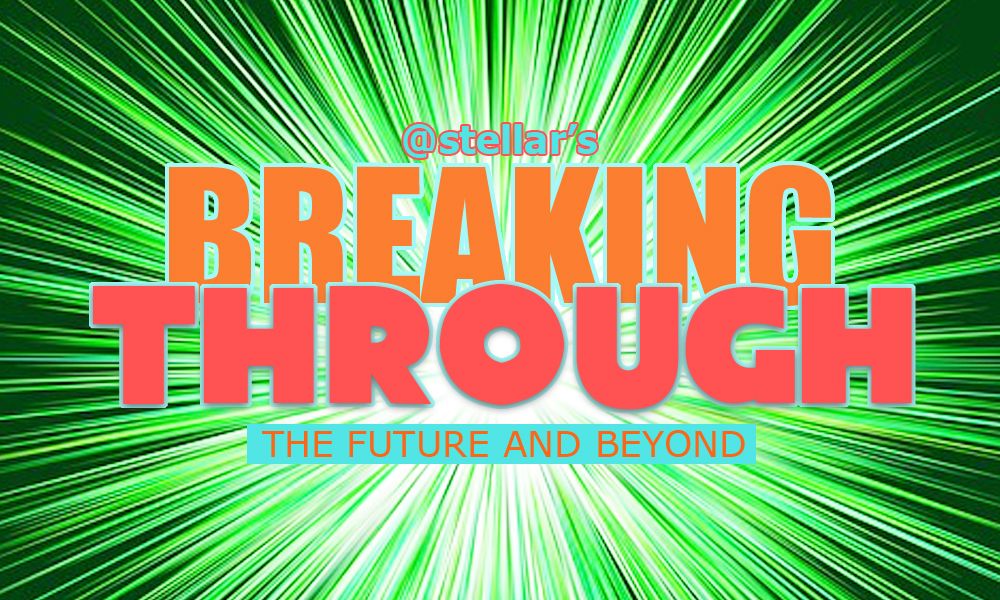</center> Today, I'm going to start a new series that will feature exceptional advancements, groundbreaking inventions, mind blowing theories, and even life altering events in science, technology, medicine, and other fields that defined the course of history and reshaped the future of mankind. #### This is Breaking Through. #### <p></p> For my first issue, I will feature an instrument that takes pictures of stars, planets, galaxies, black holes, and other space phenomenons, thus revolutionizing space explorations and astronomical research - **[The Hubble Telescope](https://en.wikipedia.org/wiki/Hubble_Space_Telescope).** The Hubble Telescope is a space telescope named after Astronomer [Edwin Hubble](https://en.wikipedia.org/wiki/Edwin_Hubble) and was launched into low Earth orbit by Space Shuttle [Discovery](https://en.wikipedia.org/wiki/Space_Shuttle_Discovery) in April 24, 1990. <center> <sub>The Hubble Telescope in orbit, [By Ruffnax (Crew of STS-125)](http://spaceflight.nasa.gov/gallery/images/shuttle/sts-119/hires/s125e011848.jpg)</sub></center> It has been in orbit for **27 years, 7 months and 22 day**s and has made more than **1.3 million** observations that was used by astronomers to publish more than **15,000** scientific papers. The Hubble archive contains **140 terabytes** of data and an additional 10 terabytes are added each year. The telescope is as long as a large school bus at **13.3 meters (43.5 feet)*”. It initially weighs 21,000 lbs but after the final servicing mission in 2009, it now weighs **24,000 lbs**. Its primary mirror is 94.5 inches (2.4 meters) in diameter, relatively small compared to ground-based telescopes which have mirrors 400 inches up in diameter. It has a *pointing accuracy of .007 [arc seconds](en.wikipedia.org/wiki/Minute_and_second_of_arc) which is like being able to shine a laser beam focused on Franklin D. Roosevelt's head on a dime roughly 200 miles away.* It can see an object at *an angular size of 0.05 arcseconds, which is like seeing a pair of fireflies in Tokyo from your home in Maryland.* That power enabled the Hubble to look at a very distant past and to a location *13.4 billion light years away from Earth*. How far is that? Well, 1 light-year is about 9.5 trillion kilometers. The Hubble was launched to space to avoid haze, pollution, and atmospheric distortions that affects the view of telescope on the ground. So at **353 miles (569 km)** above the Earth’s surface, the Hubble has a better view of the universe compared to other ground-based telescopes. Up there, it travels at 5 miles per second (8 km per second) while taking pictures of the universe. Every 97 minutes, it makes a complete spin around our planet and since its launch, it has travelled 4 billion miles. The Hubble is a [Cassegrain reflector](https://en.m.wikipedia.org/wiki/Cassegrain_reflector), a type of telescope with a primary concave mirror and minor convex mirror. <center>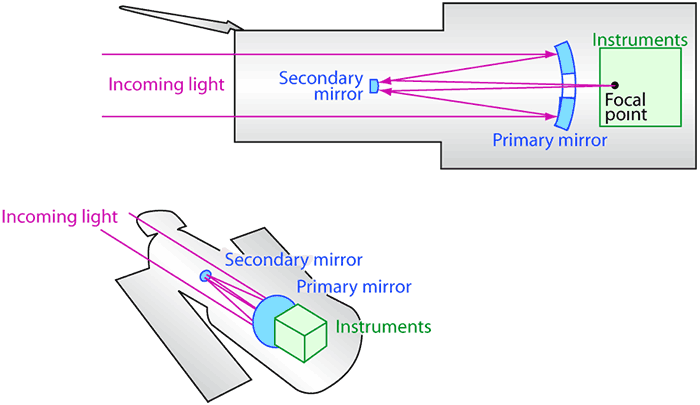<sub>The path of light inside Hubble Telescope, [Hubblesite](http://hubblesite.org/the_telescope/hubble_essentials/image.php?image=light-path)</sub></center> The light captured by the main mirror is pass to the minor mirror. The minor mirror then focus the light through a hole in the center of the primary mirror leading it to the scientific instruments of the telescope. The scientific instruments will then work together or individually to process the light and each instrument is designed to observe the universe in different ways. One of the two newest instruments of the Hubble is the [Wild Field Camera 3 (WFC3)](http://hubblesite.org/the_telescope/nuts_.and._bolts/instruments/wfc3/). It can separately see near-ultraviolet, visible, and near-infrared lights and will be used to study dark matter, dark energy, and star formation. It will also be used in exploring extremely remote galaxies previously beyond the telescope’s range. <center>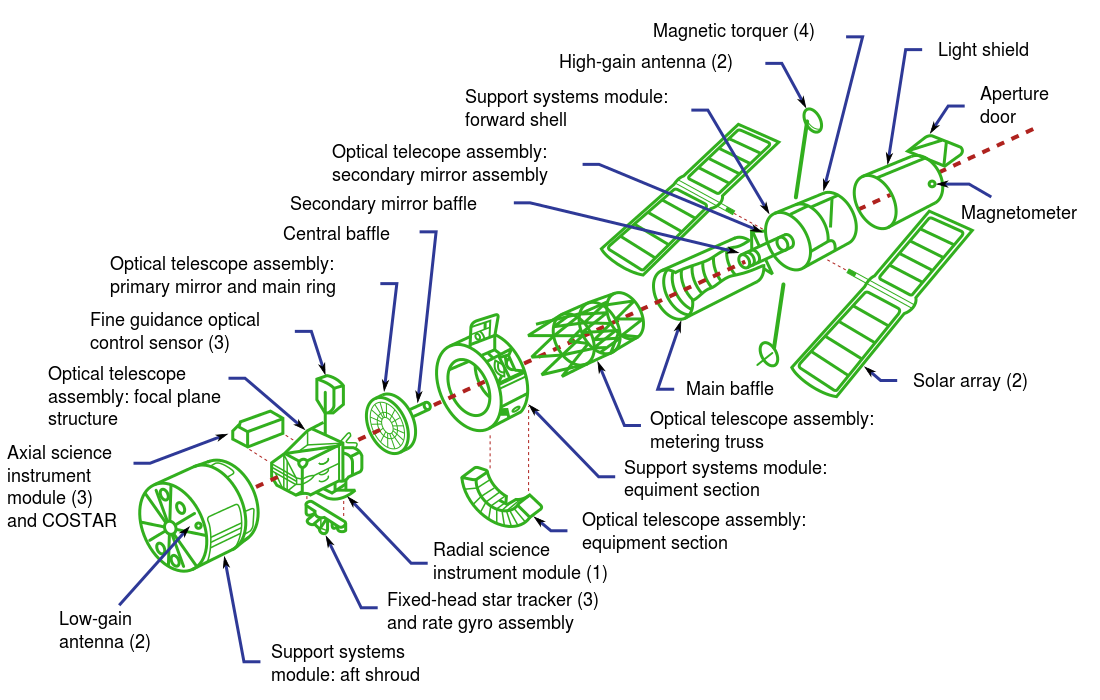<sub>Exploded view, [By AndrewBuck,](Wikimediahttps://commons.wikimedia.org/w/index.php?curid=9708761)</sub></center> The Hubble’s other newest instrument is the [Cosmic Origins Spectrograph (COS)](http://hubblesite.org/the_telescope/nuts_.and._bolts/instruments/cos/) which can only see ultraviolet lights. Spectrographs breaks lights from the cosmos into its component and is useful in providing wavelength fingerprints of objects being observed. With the help of COS, scientists can now know the temperature, chemical composition, density, and motion of an object like stars or planets. The [Advanced Camera for Surveys (ACS)](http://hubblesite.org/the_telescope/nuts_.and._bolts/instruments/acs/index.php) sees visible light and is used to study early activities in the universe, map distribution of dark matter, detect most distant objects, search massive planets, and study the evolution of galaxies. The [Space Telescope Imaging Spectrograph (STIS)](http://hubblesite.org/the_telescope/nuts_.and._bolts/instruments/stis/index.php) is a spectrograph used for hunting black holes. It sees ultraviolet, visible and near-infrared light, and can map out larger objects like galaxies. The [Near Infrared Camera and Multi-Object Spectrometer (NICMOS)](http://hubblesite.org/the_telescope/nuts_.and._bolts/instruments/nicmos/index.php) is the heat sensor of the Hubble as it sees infrared light which is useful in finding objects hidden in space dust. The last instrument is the [Fine Guidance Sensors (FGS)](http://hubblesite.org/the_telescope/nuts_.and._bolts/instruments/fgs/index.php) which keeps the telescope pointed in the right direction. They can be used to measure distance between stars and their relative motion. The Hubble is equipped with solar arrays that convert sunlight to electricity to power its operations. Electricity is stored in batteries to to be used when the telescope is behind the Earth’s shadow, blocked from sunlight. For years, the Hubble has been releasing astonishing images from the universe. Below is an image of 2 galaxies merging to form a cosmic knot now known as NGC **2623 or Arp 243** located about 250 light-years away in the constellation of Cancer. <center>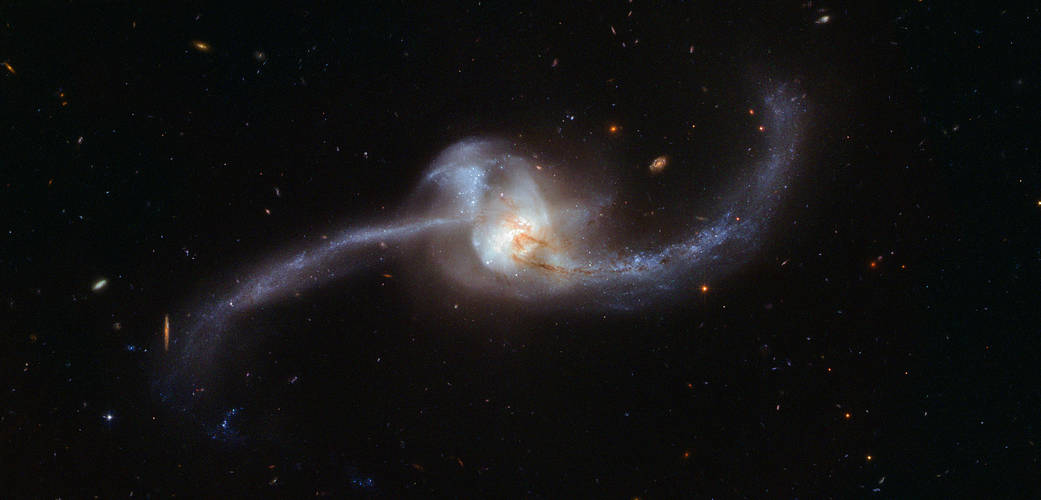 <sub>What happens when two galaxies become one, [NASA/ESA](https://www.nasa.gov/image-feature/goddard/2017/hubble-unravels-a-twisted-cosmic-knot)</sub></center> But how does Hubble come out with such beautiful, almost unbelievable images? <center>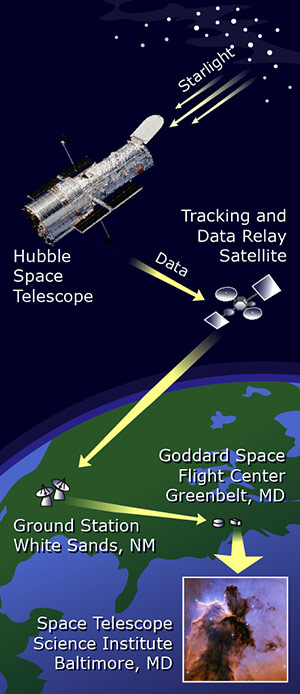 <sub>From light to image, the path of data from Hubble to Earth, [Hubblesite](http://hubblesite.org/the_telescope/hubble_essentials/image.php?image=pipeline)</sub></center> The Hubble has 4 antennae that send and receive information between Hubble and the **Flight Operations Team** at the **Goddard Space Flight Center in Greenbelt, Maryland**. Its **Flight Operations Team** commands, communicates, and controls the telescope using satellites. The data captured by Hubble are sent to the ground station located in White Sands, New Mexico. From there, it will be transferred to Goddard. Goddard will then send the data to **Space Telescope Science Institute (STScI)**. Scientists from STScI will then process the data into [images](http://hubblesite.org/images/gallery) by translating it *into scientifically meaningful units — such as wavelength or brightness*. The result will then be put to [archive accessible to astronomers](https://hla.stsci.edu) via the internet. Who can use the telescope? According to NASA, [anyone](www.nasa.gov/mission_pages/hubble/servicing/series/How_science_is_done.html) - without restrictions on nationality and academic affiliation, can apply for observing time on the Hubble Space Telescope. Astronomers and scientists from around the world compete for a chance to use the telescope. They must submit a proposal which will be reviewed by STScI. Winning proposals get the chance to use the telescope. Every year, about 200 proposals are selected out of 1000 submissions. Since its launch, The Hubble Space Telescope is breaking through a lot of scientific discoveries. It proved previous theories and assumptions in astronomy and astrophysics. It discovered stars, galaxies, black holes, and even the age of the universe which is about 13-14 billion years. With the Hubble on its orbit, expect the universe to unravel more mind-boggling mysteries. <center> <br/> <sub>Sources: [NASA](https://www.nasa.gov/mission_pages/hubble/story/index.html) • [Hubblesite](http://hubblesite.org/the_telescope/hubble_essentials/) • [Wikipedia](https://en.wikipedia.org/wiki/Hubble_Space_Telescope) • [PhotographyTalk](https://www.photographytalk.com/photography-articles/8090-after-27-years-in-service-hubble-s-telescope-and-camera-are-a-mystery-to-most)</sub> <br/> ___ Be Curious! Follow Random Collective by @st3llar. ___ </center>
👍 anomaly, alphacore, andre-verbrick, busy.org, steemitbc, eastmael, steemitph, anonimnotoriu, minnowsupport, banjo, st3llar, edrivegom, stephen.king989, teofilex11, steemprentice, lastminuteman, pomperipossa, gindor, beng05, cryptohustler, robertvogt, gamerveda, dirty.hera, jhermanbeans, valth, numpypython, decibel, starsteem, jhagi.bhai, whatamidoing, timbalabuch, qwasert, taica, pusteblume, whiessl, maxer27, derosnec, myday, nesbitt, bearone, funshoppe, drotto, lil.toughcookie, justtryme90, zararina, steemstem, lafona-miner, timsaid, lemouth, techslut, jamhuery, mobbs, kenchung, alexander.alexis, ovij, azirgraff, kedi, ongoingwow, dna-replication, curie, liberosist, ratticus, meerkat, belgarath, erangvee, dante31, gambit.coin, hyplooper, jasimg, elmubareki, raju12, hendrikdegrote, anwenbaumeister, steempty, kushed, fminerten, pharesim, xeroc, oleg326756, toxichan, funnyman, steemedia, cebymaster, cotidiana, authornick, pacokam8, slayerkm, bp423, oscarcc89, arrliinn, diggerdugg, sieses, gamesjoyce, samether, phenom, dan-bn, papaeducation, prince-octavian, anarchyhasnogods, kyriacos, the-devil, foundation, himal, lamouthe, rachelsmantra, kerriknox, nitesh9, gra, rjbauer85, rockeynayak, mirhimayun, papadimos, pearlumie, sci-guy, stempede, cryptoninja, joebrandth, dreamiely, dber, amavi, gentleshaid, kayes12345, kryzsec, bobsthinking,